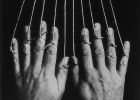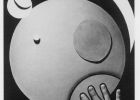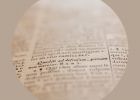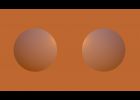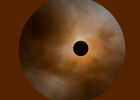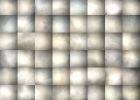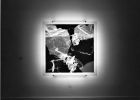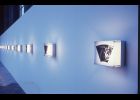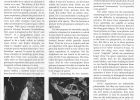Flusser Studies 32 – November 2021
Aberturas / Opening
“Openings” is the first of four essays written by Vilém Flusser regarding the work of Russian-Brazilian painter Samson Flexor (1907-1971). Published in “Suplemento Literário do Estado de São Paulo”, the article is marked by a heideggerian-existentialist style and presents what is probably Flusser's first concrete dive into a monstrous imaginary during his years in Brazil, where the philosopher lived between 1940 and 1973. Flusser's essays on Flexor are dated between 1967 and 71 and cover the “Bipeds” phase and the so-called “white” phase from the painter’s work. Later he would write one last essay, called “Flexor: in memoriam”, for the painter’s biography, written by Alice Brill in 1990. This Portuguese-English translation of “Aberturas” includes one photograph of Flexor with some of his "Bipeds" at the IX Bienal de São Paulo, in 1967.
Ontogenese wiederholt Phylogenese / Ontogenesis repeats Phylogenesis
“Ontogenesis repeats Phylogenesis” is the first introductory text of Flusser’s last book Menschwerdung (Becoming human) that was not completed because of Flusser’s sudden death in 1991. It was published in 1994 by Stefan Bollmann and Edith Flusser with the collaboration of Klaus Sander in Vom Subjekt zum Projekt /Menschwerdung (From Subject to Project / Becoming Human). Two other unpublished texts from this book project were already published in Flusser Studies 12 (“Pünktlich” and “Was man wollen kann”). In “Ontogenesis repeats Phylogenesis”, Flusser compares the development of the individual to that of the species, presenting his book project as a summa of his whole thinking. It is a text written in maturity, at the end of the second millennium after Christ’s death. Flusser describes himself ironically as the last Mohican who by writing his personal history, is also writing the history of the Mohican tribe, the Jews of Prague, most of whom were annihilated in the Holocaust.
Jogos / Spiele / Games
In this essay, Flusser identifies human beings as homo ludens, the playing animal, asserting that the capacity to play is their defining feature. He notes at the outset that it is no longer the difference between humans and animals that is at issue, but a difference between humans and their apparatuses. In supporting his claim, he defines a game as system of elements that regularly combine, then goes on to describe categories of games within which the whole of human communication can be aligned. He focusses on three examples -- chess, language (he chooses Portuguese), and science, using them to introduce terms, e.g. “elements,” “competence,” “repertoire” and “universe,” that apply to games in general but also facilitate comparison and contrast. Above all, he underscores the need for human beings to be aware of the games in which they participate, for only in such an awareness is it possible to actually play a game -- that is, expand and change it, create something new -- as opposed to being played by it, caught in the operations of a fixed, stolid, apparatus. First published in German in 1968, the text introduces terms that Flusser developed further in subsequent writings.
Reflexion. Henry Lewis: X-Räume / Reflexion. Henry Lewis: X-spaces / Henry Lewis, X-Spaces
In 1990, “European Photography” published a text by Vilém Flusser on the work of the photographer Henry Lewis: „Henry Lewis: X-Spaces (41/11, 1990: 46-47). In this essay, Flusser discusses the impossibility to experience space with the eyes. We can only reach as far as the surface of objects, he writes, but radiography penetrates beyond the surface into space. Flusser contends that Henry Lewis is not interested in finding out what is behind the surface, but in making the experience of space visible. He is making pictures of the third dimension.
Brief Encounter with Vilém Flusser. An Interview
In this interview, Henry Lewis, who originally comes from Australia where he now lives again, speaks about his early interest in photography, the years he spent in France and his relationship to Vilém Flusser. His work as a photographer was not only influenced by other photographers like Man Ray – especially the Rayographs -, Tom Dahos, Jürgen Klauke, Juan Fontcuberta, but also by painters and sculptors like Ellsworth Kelly. Lewis got to know Flusser through Andreas Müller-Pohle whom he had showed his radiographic work and who suggested that he made contact with Vilém Flusser in Robion. Lewis and his wife Christiane visited Vilém and Edith Flusser in the South of France several times. Lewis also talks about Flusser’s influence on his work, the relevance of Flusser’s work thirty years after his death, and the future of photography.
Flusser’s Belief
This text is the third chapter of David Levis Strauss’ Photography and Belief, an examination of past and present convictions about the reality, authenticity, trustworthiness of the photographic image. Following on from considerations of the subjectivity of a photograph as developed by Benjamin, Barthes, and Berger, the photograph’s status as a sign and the implications of its indexicality, this chapter positions photography in a far broader context. For Flusser recognises the photograph as the onset of a shift in human communications as vast as the invention of writing, introducing visual codes that undermine those of alphabetic writing, and opening completely different means of generating and storing information. Although Flusser spoke little of belief as such, he did speak often of doubt. If we accept that doubt is not the opposite of belief, but of certainty, his approach touches continually on questions of belief. For Flusser remains uncertain whether the new society based on technical images – the first being the photograph – will be the most creatively exciting, humane society the world has ever known, or its very opposite, a mindless network of functionaries.
Língua é realidade: Vilém Flusser e a obra de Guimarães Rosa
This essay examines the dialogue established between Vilém Flusser and João Guimarães Rosa around the conception of language as the creator of reality. In this text, we discuss elements of this dialogue, We consider how the two authors understand language and how this understanding appears expressed in their works, based on essays and testimonies given by both. In this relationship between these two authors and friends, the works’ interrelation is given from the Flusser’s point of view, in his account of the profound impact of Guimarães Rosa’s literature on Flusser, who wrote several essays on it, and in seeing the experience of his own ideas about the language in Rosa’s work.
“Documentar algo que no existe”: los modelos discursivos como apparatus en Vampyroteuthis Infernalis
The concept of “apparatus”, proposed by Vilém Flusser in his Towards a Philosophy of Photography, implies an analysis of the “production logic” of the artistic work, which Flusser proposed thinking about photography. However, this concept also offers a possibility of reading his Vamyproteuhis Infernalis as a rebellion against the discursive rules that themselves work as an “apparatus” . By questioning the rules of scientific, philosophical, didactic and literary discourses, Flusser plays with the mechanisms of the discourse and deactivates their automatisms. This leads to questions like the boundaries of art, creation as a form of knowledge, or imitation and scientific study of reality as a need in artistic, literary creation, and methodologies of “scientific creation”.
Trying Things Out. A Flusserian Vision for the Future of Science
My goal in this paper is twofold. First, I want to analyze two early texts by Vilém Flusser in order to explore what may have been his conceptualization of the relationship between science and philosophy. My analysis suggests that Flusser thought of both as tools to analyze reality by analyzing language. While he saw science as a (sometimes too vigorous) force forward, he viewed philosophy as what can prevent some of the negative consequences of such progress. In direct comparison, Flusser thought of science as a discourse with the purpose to provide novel information and of philosophy as what can keep objective science in check by moving the discourse into the realm of the subjective. It remains to be explored whether these results also apply to Flusser’s later writings. My second goal is to show the relationship between three aspects of modern science (crisis, contrast, and trying out) and what I see as Flusser’s early (mid 1960s) view of science in relation to philosophy and poetry.
